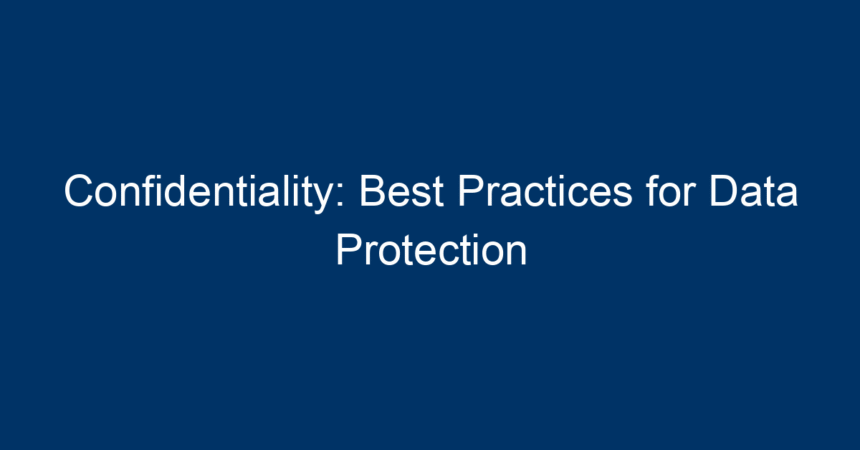In today’s digital landscape, where data breaches are more commonplace than ever, maintaining confidentiality is critical for businesses and individuals alike. With the increase in cyber threats and regulatory scrutiny, understanding the best practices for data protection is essential. This article will explore the concept of confidentiality, its importance, and the best practices to ensure data protection.
Understanding Confidentiality
Confidentiality refers to the ethical principle of keeping information private and secure. This extends to personal data, proprietary business information, and sensitive communications. By maintaining confidentiality, organizations can protect their assets, maintain trust with clients and stakeholders, and comply with various regulations.
The Importance of Confidentiality
The implications of failing to uphold confidentiality can be severe. Data breaches can lead to financial loss, legal consequences, and irreparable damage to a brand’s reputation. Here are some key reasons why confidentiality is paramount:
- Trust Building: When clients know their information is secure, they are more likely to engage with a business.
- Legal Compliance: Regulations like GDPR and HIPAA mandate strict data confidentiality standards.
- Mitigation of Risks: Protecting sensitive information can help prevent identity theft and fraud.
Best Practices for Ensuring Confidentiality
To solidify your data protection strategies, consider implementing the following best practices:
1. Data Classification
Begin by classifying data based on its sensitivity. This allows for targeted protection measures. For instance, personal identifiable information (PII) should be treated with a higher level of confidentiality compared to less sensitive data. Implement a data classification policy that outlines categories such as:
- Public: Information that can be shared with anyone.
- Internal: Information intended for internal use only.
- Confidential: Sensitive information that should be accessed only by authorized personnel.
- Restricted: Highly sensitive data requiring rigorous access controls.
2. Strong Access Controls
Implementing strong access controls is vital in maintaining confidentiality. Limit access to sensitive data based on job roles and responsibilities. Use role-based access controls (RBAC) to ensure that only authorized users can access confidential information.
Multifactor Authentication (MFA)
Enhance security further by requiring multifactor authentication. This adds an extra layer of protection, making it more difficult for unauthorized individuals to gain access.
3. Data Encryption
Data encryption converts information into a secure format that can only be read by someone with the decryption key. This is especially important for data in transit and data at rest. Utilizing encryption technologies helps ensure that confidential information remains secure even if it is intercepted or accessed by unauthorized individuals.
4. Regular Audits and Assessments
Conduct regular audits to identify vulnerabilities and assess compliance with confidentiality policies. By routinely evaluating your data protection measures, you can spot areas for improvement and adapt to new risks.
Utilize a combination of automated tools and manual inspections to ensure comprehensive coverage during audits.
5. Employee Training and Awareness
Your employees are the first line of defense in maintaining confidentiality. Regular training sessions should be conducted to educate staff about the importance of data protection, recognizing phishing attempts, and proper data handling procedures.
Creating a Culture of Confidentiality
Foster an organizational culture that prioritizes confidentiality. Encourage open discussions about data protection and reward employees for following best practices.
6. Secure Data Disposal
Sensitive information must be disposed of properly to avoid data leaks. Implement data disposal policies that include:
- Data Sanitization: Use software to overwrite data before deleting it.
- Physical Destruction: For hardware containing sensitive information, ensure that it is physically destroyed.
7. Incident Response Plan
Develop an incident response plan to address potential data breaches. This plan should outline:
- Notification Procedures: How and when to notify affected parties.
- Containment Measures: Steps to limit the damage during a breach.
- Post-Incident Analysis: Review the incident to improve future responses.
8. Use of Secure Communication Channels
When sharing confidential information, always utilize secure communication channels. Use encrypted emails, secure file transfer protocols, or private communication platforms to minimize the risk of interception.
9. Data Minimization
Practice data minimization by only collecting and retaining information that is necessary for your business operations. Limit the amount of confidential data collected to mitigate risks and reduce the burden of data management.
10. Compliance with Regulations
Stay informed about data protection regulations relevant to your industry. Regularly review and update your data protection policies to ensure compliance with laws such as GDPR, HIPAA, or CCPA. This not only helps maintain confidentiality but also avoids potential fines and legal action.
Conclusion: Actionable Insights for Enhanced Confidentiality
Maintaining confidentiality is a continuous process that requires diligence and commitment. By following the best practices outlined in this article, organizations can bolster their data protection strategies and safeguard sensitive information. Here’s a quick recap of actionable steps:
- Classify Data: Understand the sensitivity of your data and manage it accordingly.
- Implement Access Controls: Define who can access confidential information.
- Encrypt Information: Protect data using encryption technologies.
- Conduct Regular Audits: Evaluate your security measures consistently.
- Train Employees: Build a knowledgeable and vigilant workforce.
- Dispose of Data Securely: Follow proper protocols for data disposal.
- Establish an Incident Response Plan: Be prepared for potential breaches.
- Use Secure Communication: Choose safe channels for sharing confidential information.
- Practice Data Minimization: Only collect what you need.
- Stay Compliant: Regularly update policies in line with regulatory requirements.
In an age where data is often regarded as the new gold, ensuring confidentiality is more critical than ever. By adopting these best practices, you can protect your data, build trust, and enhance the overall security posture of your organization. Whether you are a small business or a large corporation, prioritizing confidentiality is not just a necessity but a responsibility. Engage with your data protection strategy today to secure your future tomorrow.




